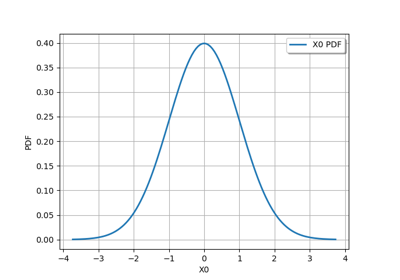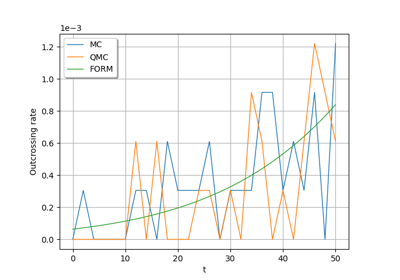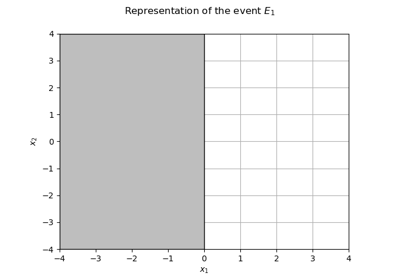Matrix¶
- class Matrix(*args)¶
Real rectangular matrix.
- Parameters:
- n_rowsint,
, optional
Number of rows. Default is 1.
- n_columnsint,
, optional
Number of columns. Default is 1.
- valuessequence of float with size
, optional
Values. column-major ordering is used (like Fortran) for reshaping the flat list of values. Default creates a zero matrix.
- n_rowsint,
Methods
clean(threshold)Set elements smaller than a threshold to zero.
computeGram([transpose])Compute the associated Gram matrix.
computeHadamardProduct(other)Compute the Hadamard product matrix.
computeQR([fullQR])Compute the QR factorization.
computeQRInPlace([fullQR])Compute the QR factorization in place.
computeSVD([fullSVD])Compute the singular values decomposition (SVD).
computeSVDInPlace([fullSVD])Compute the singular values decomposition (SVD).
Compute the singular values.
Compute the singular values in place.
Compute the sum of the matrix elements.
Frobenius norm accessor.
Accessor to the object's name.
getDiagonal([k])Get the k-th diagonal of the matrix.
getDiagonalAsPoint([k])Get the k-th diagonal of the matrix.
getId()Accessor to the object's id.
Accessor to the underlying implementation.
getName()Accessor to the object's name.
Accessor to the number of columns.
Accessor to the number of rows.
isEmpty()Tell if the matrix is empty.
reshape(newRowDim, newColDim)Reshape the matrix.
reshapeInPlace(newRowDim, newColDim)Reshape the matrix, in place.
setDiagonal(*args)Set the k-th diagonal of the matrix.
setName(name)Accessor to the object's name.
solveLinearSystem(*args)Solve a rectangular linear system whose the present matrix is the operator.
solveLinearSystemInPlace(*args)Solve a rectangular linear system whose the present matrix is the operator.
Square the Matrix, ie each element of the matrix is squared.
Transpose the matrix.
Examples
Create a matrix
>>> import openturns as ot >>> M = ot.Matrix(2, 2, range(2 * 2)) >>> print(M) [[ 0 2 ] [ 1 3 ]]
Get or set terms
>>> print(M[0, 0]) 0.0 >>> M[0, 0] = 1. >>> print(M[0, 0]) 1.0 >>> print(M[:, 0]) [[ 1 ] [ 1 ]]
Create an openturns matrix from a numpy 2d-array (or matrix, or 2d-list)…
>>> import numpy as np >>> np_2d_array = np.array([[1.0, 2.0, 3.0], [4.0, 5.0, 6.0]]) >>> ot_matrix = ot.Matrix(np_2d_array)
and back
>>> np_matrix = np.matrix(ot_matrix)
Basic linear algebra operations (provided the dimensions are compatible)
>>> A = ot.Matrix([[1.0, 2.0], [3.0, 4.0], [5.0, 6.0]]) >>> B = ot.Matrix(np.eye(2)) >>> C = ot.Matrix(3, 2, [1.] * 3 * 2) >>> print(A * B - C) [[ 0 1 ] [ 2 3 ] [ 4 5 ]]
- __init__(*args)¶
- clean(threshold)¶
Set elements smaller than a threshold to zero.
- Parameters:
- thresholdfloat
Threshold for zeroing elements.
- Returns:
- cleaned_matrix
Matrix Input matrix with elements smaller than the threshold set to zero.
- cleaned_matrix
- computeGram(transpose=True)¶
Compute the associated Gram matrix.
- Parameters:
- transposedbool
Tells if matrix is to be transposed or not. Default value is True
- Returns:
- MMT
Matrix The Gram matrix.
- MMT
Notes
When transposed is True, compute
. Otherwise, compute
.
Examples
>>> import openturns as ot >>> M = ot.Matrix([[1.0, 2.0], [3.0, 4.0], [5.0, 6.0]]) >>> MtM = M.computeGram() >>> print(MtM) [[ 35 44 ] [ 44 56 ]] >>> MMt = M.computeGram(False) >>> print(MMt) [[ 5 11 17 ] [ 11 25 39 ] [ 17 39 61 ]]
- computeHadamardProduct(other)¶
Compute the Hadamard product matrix.
Notes
The matrix
resulting from the Hadamard product ( also known as the elementwise product) of the matrices
and
is:
for any
and
.
Examples
>>> import openturns as ot >>> A = ot.Matrix([[1.0, 2.0], [3.0, 4.0]]) >>> B = ot.Matrix([[1.0, 2.0], [3.0, 4.0]]) >>> C = A.computeHadamardProduct(B) >>> print(C) [[ 1 4 ] [ 9 16 ]] >>> print(B.computeHadamardProduct(A)) [[ 1 4 ] [ 9 16 ]]
- computeQR(fullQR=False)¶
Compute the QR factorization.
By default, it is the economic decomposition which is computed. The economic QR factorization of a rectangular matrix
with
(more rows than columns) is defined as follows:
where
is an
upper triangular matrix,
is
,
is
, and
and
both have orthogonal columns.
- Parameters:
- full_qrbool, optional
A flag telling whether Q, R or Q1, R1 are returned. Default is False and returns Q1, R1.
- Returns:
- Q1
Matrix The orthogonal matrix of the economic QR factorization.
- R1
TriangularMatrix The right (upper) triangular matrix of the economic QR factorization.
- Q
Matrix The orthogonal matrix of the full QR factorization.
- R
TriangularMatrix The right (upper) triangular matrix of the full QR factorization.
- Q1
Notes
The economic QR factorization is often used for solving overdetermined linear systems (where the operator
has
) in the least-square sense because it implies solving a (simple) triangular system:
This uses LAPACK’s DGEQRF and DORGQR.
Examples
>>> import openturns as ot >>> import numpy as np >>> M = ot.Matrix([[1.0, 2.0], [3.0, 4.0], [5.0, 6.0]]) >>> Q1, R1 = M.computeQR() >>> np.testing.assert_array_almost_equal(Q1 * R1, M)
- computeQRInPlace(fullQR=False)¶
Compute the QR factorization in place.
Similar to
computeQR()
- computeSVD(fullSVD=False)¶
Compute the singular values decomposition (SVD).
The singular values decomposition of a rectangular matrix
with size
reads:
where
is an
orthogonal matrix,
is an
diagonal matrix and
is an
orthogonal matrix.
- Parameters:
- fullSVDbool, optional
Whether the null parts of the orthogonal factors are explicitly stored or not. Default is False and computes a reduced SVD.
- Returns:
- singular_values
Point The vector of singular values with size
that form the diagonal of the
matrix
of the SVD.
- U
SquareMatrix The left orthogonal matrix of the SVD.
- VT
SquareMatrix The transposed right orthogonal matrix of the SVD.
- singular_values
Notes
This uses LAPACK’s DGESDD.
Examples
>>> import openturns as ot >>> import numpy as np >>> M = ot.Matrix([[1.0, 2.0], [3.0, 4.0], [5.0, 6.0]]) >>> singular_values, U, VT = M.computeSVD(True) >>> Sigma = ot.Matrix(M.getNbRows(), M.getNbColumns()) >>> for i in range(singular_values.getSize()): ... Sigma[i, i] = singular_values[i] >>> np.testing.assert_array_almost_equal(U * Sigma * VT, M)
- computeSVDInPlace(fullSVD=False)¶
Compute the singular values decomposition (SVD).
Unlike computeSVD, this modifies the matrix in place and avoids a copy.
- computeSingularValues()¶
Compute the singular values.
- Parameters:
- fullSVDbool, optional
Whether the null parts of the orthogonal factors are explicitly stored or not. Default is False and computes a reduced SVD.
- Returns:
- singular_values
Point The vector of singular values with size
that form the diagonal of the
matrix
of the SVD decomposition.
- singular_values
See also
Examples
>>> import openturns as ot >>> M = ot.Matrix([[1.0, 2.0], [3.0, 4.0], [5.0, 6.0]]) >>> print(M.computeSingularValues()) [9.52552,0.514301]
- computeSingularValuesInPlace()¶
Compute the singular values in place.
Similar to
computeSingularValues()but the matrix is modified in place to avoid copy.
- computeSumElements()¶
Compute the sum of the matrix elements.
- Returns:
- suma float
The sum of the elements.
Notes
Compute the sum of elements of the matrix
:
Examples
>>> import openturns as ot >>> M = ot.Matrix([[1.0, 2.0], [3.0, 4.0], [5.0, 6.0]]) >>> s = M.computeSumElements() >>> print(s) 21.0
- frobeniusNorm()¶
Frobenius norm accessor.
- Returns:
- normfloat
The Frobenius norm
.
- getClassName()¶
Accessor to the object’s name.
- Returns:
- class_namestr
The object class name (object.__class__.__name__).
- getDiagonal(k=0)¶
Get the k-th diagonal of the matrix.
- Parameters:
- kint
The k-th diagonal to extract Default value is 0
- Returns:
- D:
Matrix The k-th diagonal.
- D:
Examples
>>> import openturns as ot >>> M = ot.Matrix([[1.0, 2.0, 3.0], [4.0, 5.0, 6.0], [7.0, 8.0, 9.0]]) >>> diag = M.getDiagonal() >>> print(diag) [[ 1 ] [ 5 ] [ 9 ]] >>> print(M.getDiagonal(1)) [[ 2 ] [ 6 ]]
- getDiagonalAsPoint(k=0)¶
Get the k-th diagonal of the matrix.
- Parameters:
- kint
The k-th diagonal to extract Default value is 0
- Returns:
- pt
Point The k-th digonal.
- pt
Examples
>>> import openturns as ot >>> M = ot.Matrix([[1.0, 2.0, 3.0], [4.0, 5.0, 6.0], [7.0, 8.0, 9.0]]) >>> pt = M.getDiagonalAsPoint() >>> print(pt) [1,5,9]
- getId()¶
Accessor to the object’s id.
- Returns:
- idint
Internal unique identifier.
- getImplementation()¶
Accessor to the underlying implementation.
- Returns:
- implImplementation
A copy of the underlying implementation object.
- getName()¶
Accessor to the object’s name.
- Returns:
- namestr
The name of the object.
- getNbColumns()¶
Accessor to the number of columns.
- Returns:
- n_columnsint
- getNbRows()¶
Accessor to the number of rows.
- Returns:
- n_rowsint
- isEmpty()¶
Tell if the matrix is empty.
- Returns:
- is_emptybool
True if the matrix contains no element.
Examples
>>> import openturns as ot >>> M = ot.Matrix([[]]) >>> M.isEmpty() True
- reshape(newRowDim, newColDim)¶
Reshape the matrix.
- Parameters:
- newRowDimint
The row dimension of the reshaped matrix.
- newColDimint
The column dimension of the reshaped matrix.
- Returns:
- MT
Matrix The reshaped matrix.
- MT
Notes
If the size of the reshaped matrix is smaller than the size of the matrix to be reshaped, only the
first elements are kept (in a column-major storage sense). If the size is greater, the new elements are set to zero.
Examples
>>> import openturns as ot >>> M = ot.Matrix([[1.0, 2.0], [3.0, 4.0], [5.0, 6.0]]) >>> print(M) [[ 1 2 ] [ 3 4 ] [ 5 6 ]] >>> print(M.reshape(1, 6)) 1x6 [[ 1 3 5 2 4 6 ]] >>> print(M.reshape(2, 2)) [[ 1 5 ] [ 3 2 ]] >>> print(M.reshape(2, 6)) 2x6 [[ 1 5 4 0 0 0 ] [ 3 2 6 0 0 0 ]]
- reshapeInPlace(newRowDim, newColDim)¶
Reshape the matrix, in place.
- Parameters:
- newRowDimint
The row dimension of the reshaped matrix.
- newColDimint
The column dimension of the reshaped matrix.
Notes
If the size of the reshaped matrix is smaller than the size of the matrix to be reshaped, only the
first elements are kept (in a column-major storage sense). If the size is greater, the new elements are set to zero. If the size is unchanged, no copy of data is done.
Examples
>>> import openturns as ot >>> M = ot.Matrix([[1.0, 2.0], [3.0, 4.0], [5.0, 6.0]]) >>> print(M) [[ 1 2 ] [ 3 4 ] [ 5 6 ]] >>> M.reshapeInPlace(1, 6) >>> print(M) 1x6 [[ 1 3 5 2 4 6 ]] >>> M.reshapeInPlace(2, 2) >>> print(M) [[ 1 5 ] [ 3 2 ]] >>> M.reshapeInPlace(2, 6) >>> print(M) 2x6 [[ 1 5 0 0 0 0 ] [ 3 2 0 0 0 0 ]]
- setDiagonal(*args)¶
Set the k-th diagonal of the matrix.
- Parameters:
Examples
>>> import openturns as ot >>> M = ot.Matrix([[1.0, 2.0, 3.0], [4.0, 5.0, 6.0], [7.0, 8.0, 9.0]]) >>> M.setDiagonal([-1, 23, 9]) >>> print(M) [[ -1 2 3 ] [ 4 23 6 ] [ 7 8 9 ]] >>> M.setDiagonal(1.0) >>> print(M) [[ 1 2 3 ] [ 4 1 6 ] [ 7 8 1 ]] >>> M.setDiagonal([2, 6, 9]) >>> print(M) [[ 2 2 3 ] [ 4 6 6 ] [ 7 8 9 ]]
- setName(name)¶
Accessor to the object’s name.
- Parameters:
- namestr
The name of the object.
- solveLinearSystem(*args)¶
Solve a rectangular linear system whose the present matrix is the operator.
- Parameters:
- Returns:
Notes
This will handle both matrices and vectors, as well as underdetermined, square or overdetermined linear systems although you’d better type explicitly your matrix if it has some properties that could simplify the resolution (see
TriangularMatrix,SquareMatrix).This uses LAPACK’s DGELSY. The RCOND parameter of this routine can be changed through the MatrixImplementation-DefaultSmallPivot key of the
ResourceMap.Examples
>>> import openturns as ot >>> import numpy as np >>> M = ot.Matrix([[1.0, 2.0], [3.0, 4.0], [5.0, 6.0]]) >>> b = ot.Point([1.0] * 3) >>> x = M.solveLinearSystem(b) >>> np.testing.assert_array_almost_equal(M * x, b)
- solveLinearSystemInPlace(*args)¶
Solve a rectangular linear system whose the present matrix is the operator.
Similar to
solveLinearSystem()except the matrix is modified in-place during the resolution avoiding the need to allocate an extra copy if the original copy is not re-used.
- squareElements()¶
Square the Matrix, ie each element of the matrix is squared.
Examples
>>> import openturns as ot >>> M = ot.Matrix([[1.0, 2.0], [3.0, 4.0], [5.0, 6.0]]) >>> M.squareElements() >>> print(M) [[ 1 4 ] [ 9 16 ] [ 25 36 ]]
Examples using the class¶

Sample trajectories from a Gaussian Process with correlated outputs

Use the post-analytical importance sampling algorithm

An illustrated example of a FORM probability estimate

Estimate Sobol indices on a field to point function

Create mixed deterministic and probabilistic designs of experiments

Linear Regression with interval-censored observations

Compute leave-one-out error of a polynomial chaos expansion

Compute confidence intervals of a regression model from data

Compute confidence intervals of a univariate noisy function
 OpenTURNS
OpenTURNS















































